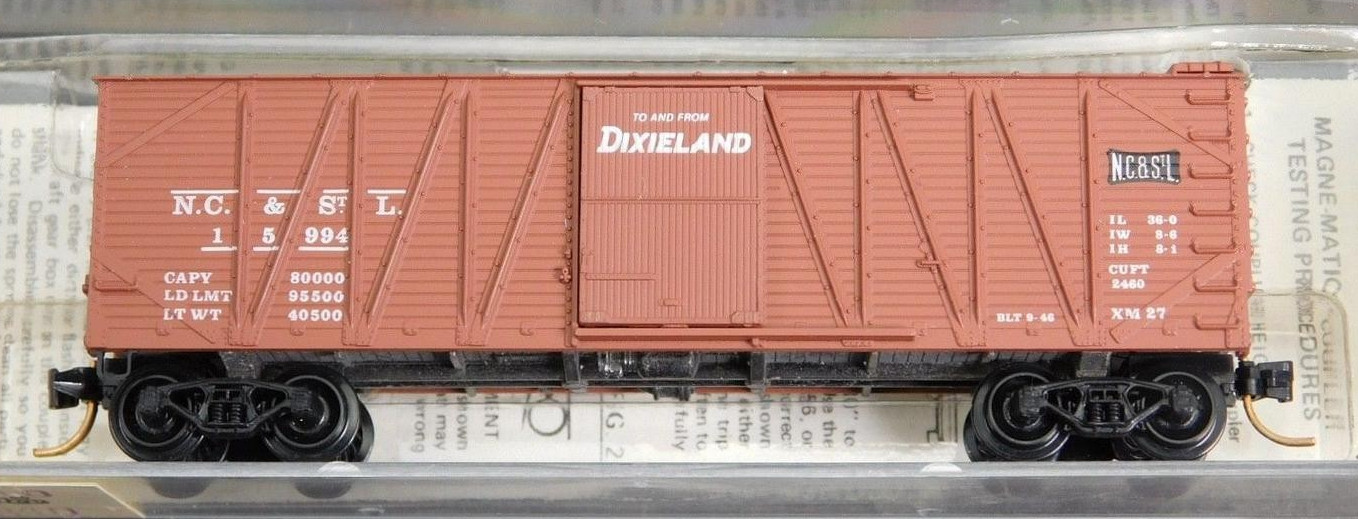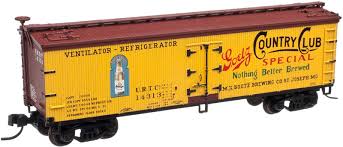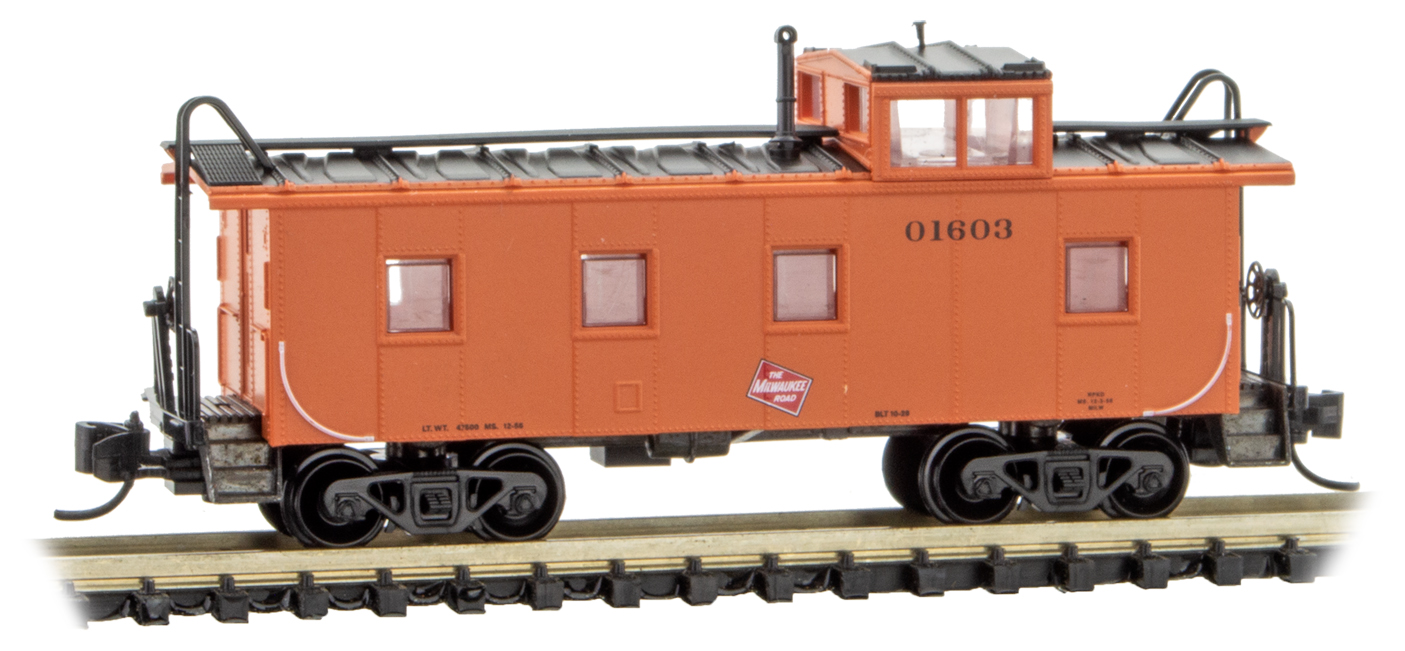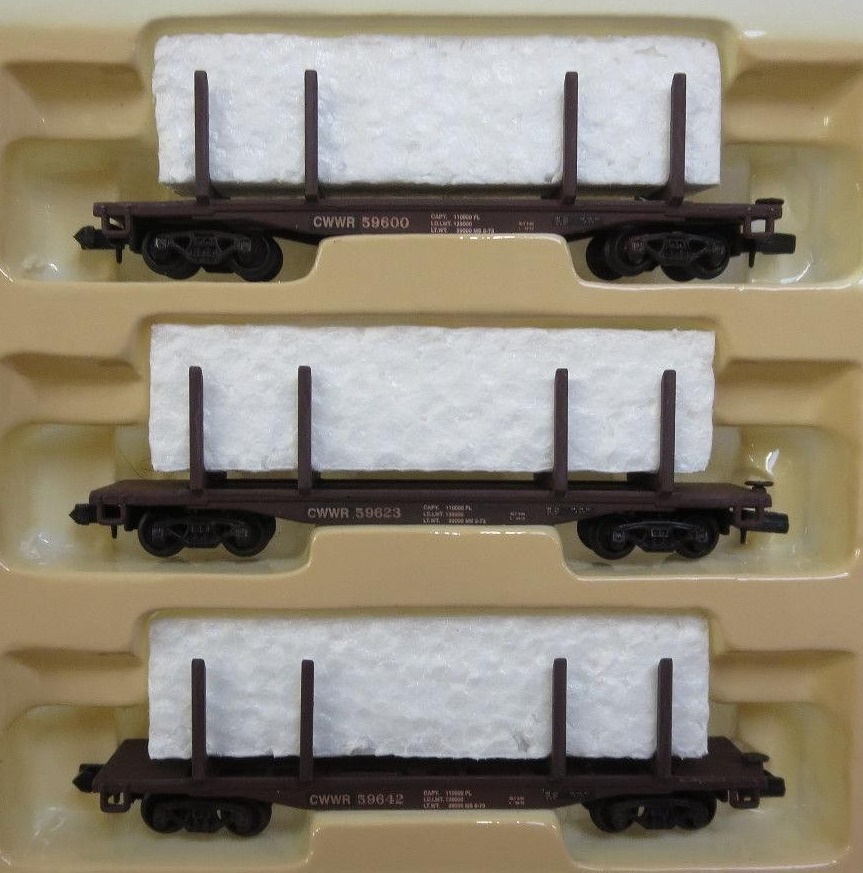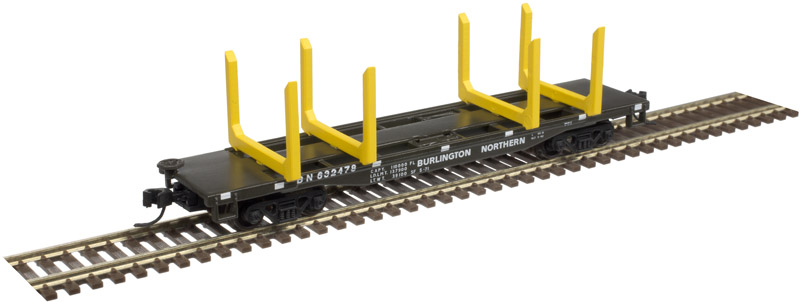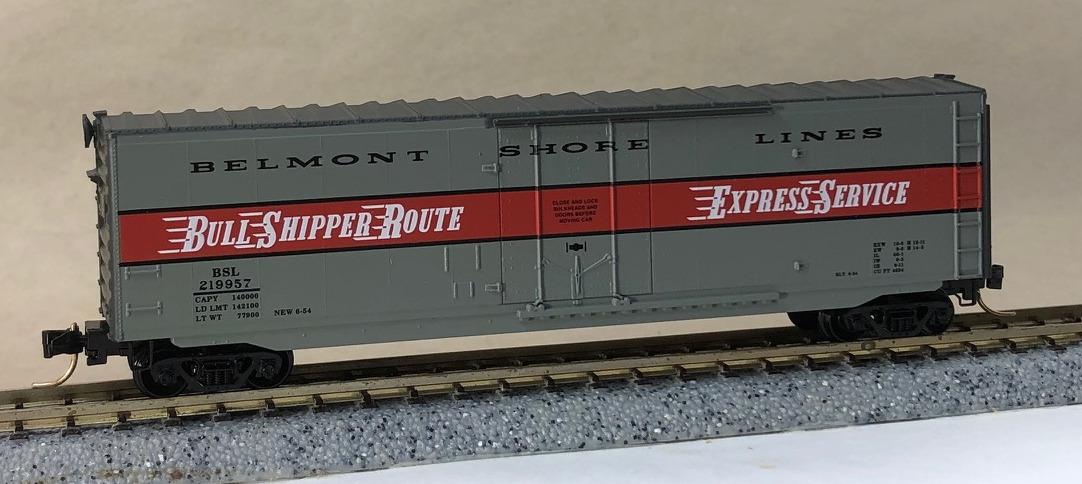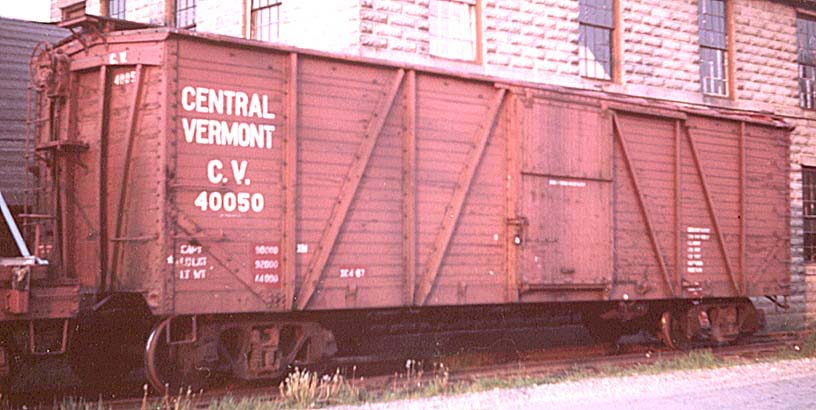Model Information: Single Wood Sheath outside braced 40 foot boxcar with a single sliding door.
Prototype History: The outside braced single sheathed box car proved to be a significant development in railway freight car technology in North America. Thousands of them saw use on North American railways beginning in the late 19th century through the 1960s. They carried bulk products such as grain and coal. They also carried packaged or bagged lading referred to as clean lading. While most of the outside braced cars were built for general service, some were built specifically to carry machinery and automobiles. For forty years freight trains on the prairies and indeed all across the country consisted of long lines of outside braced boxcars. They could commonly be found at elevators and loading platforms in communities small and large. They dominated railway yard scenes well into the 1940s.
The use of steel for the under frame (center and side sills), side and end frames initiated a new form of railway freight car building technology. Steel center sills and other under sill framing gave the cars the strength necessary to withstand the stress of longer and faster trains as well as the considerable stress involved in the contact necessary to activate closure of the knuckle coupler while being made up into trains in rail yards or from being picked up from local sidings along the line. The steel frame and the single wood side sheath minimized the weight of the car. This type of car design led to easy construction and repair. Its initial construction cost was low. The design provided secure joints between sides, ends and floors which prevented grain leakage.
The use of steel for the under frame (center and side sills), side and end frames initiated a new form of railway freight car building technology. Steel center sills and other under sill framing gave the cars the strength necessary to withstand the stress of longer and faster trains as well as the considerable stress involved in the contact necessary to activate closure of the knuckle coupler while being made up into trains in rail yards or from being picked up from local sidings along the line. The steel frame and the single wood side sheath minimized the weight of the car. This type of car design led to easy construction and repair. Its initial construction cost was low. The design provided secure joints between sides, ends and floors which prevented grain leakage.
Road Name History: 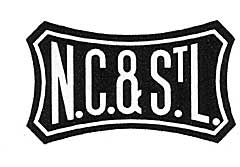 The NC&St.L (not to be confused with NYC&St.L which is the Nickel Plate Road) dates to 1845. Before 1873 it was called the Nashville & Chattanooga and locals continued to call it “the NC” until the end.
The NC&St.L (not to be confused with NYC&St.L which is the Nickel Plate Road) dates to 1845. Before 1873 it was called the Nashville & Chattanooga and locals continued to call it “the NC” until the end.
The NC&St.L ran from Memphis east to Nashville, then southeast to Chattanooga and finally Atlanta. There were also important branches to Paducah, Kentucky where they shared ownership of a bridge across the Ohio River with the CB&Q; Columbia, Tennessee; and Huntsville and Gadsden, Alabama (a big steel center.)
In 1879, NC&St.L began buying and leasing lines to reach Evansville, Indiana then west to St. Louis. In a move typical of the era, the L&N bought 55% of NC&St.L’s stock, and transferred those lines to itself. Although operated independently, the NC&St.L would remain under the control of the L&N for the next 78 years.
NC&St.L was the middle link in “the Dixie Route” for passenger trains between Chicago (or St. Louis) and Florida. Trains such as The Dixie Flagler would travel on (from north to south) C&EI, L&N, NC&St.L (from Nashville to Atlanta), Atlanta Birmingham & Coast, Atlantic Coast Line and Florida East Coast. St. Louis trains skipped the C&EI, and some others used Central of Georgia instead of the AB&C.
On the steam front, Consolidations and Mikes handled the freight with Pacific’s and Mountains pulling passengers. Most engines were equipped with Vanderbilt tenders. The only “modern” steam was a fleet of 25 4-8-4’s, the first of that wheel arrangement in the south. NC&St.L called them “Dixies” instead of Northerns. These had semi-Vanderbilt tenders (flat sides that curved inward toward the bottom), smooth boilers, and conical smoke box fronts. The first batch had wide panels on the running boards that were painted yellow. These earned the nickname “Yellow Jackets.”
North of Chattanooga, the NC&St.L crossed the Cumberland Mountains with 2.5% grades. This required pusher service. They had a trio of 2-8-8-2’s for this but often used 2-8-0’s and Mikes. Since there was nowhere to turn power at the summit, the helpers could face in either direction. Picture a long passenger train with a Yellow Jacket on the point. Passenger trains received helpers ONLY on the head end. So a 2-8-2 couples to the front of the Yellow Jacket -nose-to-nose. The Mike then leads the train over the mountains with the Vanderbilt tender leading the way. This happened routinely.
By 1953, NC&St.L had completely dieselized with an all EMD roster. F3’s and F7’s were painted blue and silver with black roofs. Geeps and switchers were painted oxide red with yellow stripes (with the exception of some dual service geeps in blue and silver.) The first batch of GP7’s were delivered with switcher trucks. There is some argument over whether they did this to save money or weight. Later groups came with standard Blomberg trucks. The F’s were used in freight and passenger service although only the B units had steam generators so a passenger train would have at least an A and B no matter how short it was.
During the 50’s, NC&St.L was 1,043 miles long (a bit longer than Lackawanna or Montana Rail Link), had 132 diesels, 106 passenger cars and 6,800 freight cars. In 1957, they were finally merged into parent L&N.

The NC&St.L ran from Memphis east to Nashville, then southeast to Chattanooga and finally Atlanta. There were also important branches to Paducah, Kentucky where they shared ownership of a bridge across the Ohio River with the CB&Q; Columbia, Tennessee; and Huntsville and Gadsden, Alabama (a big steel center.)
In 1879, NC&St.L began buying and leasing lines to reach Evansville, Indiana then west to St. Louis. In a move typical of the era, the L&N bought 55% of NC&St.L’s stock, and transferred those lines to itself. Although operated independently, the NC&St.L would remain under the control of the L&N for the next 78 years.
NC&St.L was the middle link in “the Dixie Route” for passenger trains between Chicago (or St. Louis) and Florida. Trains such as The Dixie Flagler would travel on (from north to south) C&EI, L&N, NC&St.L (from Nashville to Atlanta), Atlanta Birmingham & Coast, Atlantic Coast Line and Florida East Coast. St. Louis trains skipped the C&EI, and some others used Central of Georgia instead of the AB&C.
On the steam front, Consolidations and Mikes handled the freight with Pacific’s and Mountains pulling passengers. Most engines were equipped with Vanderbilt tenders. The only “modern” steam was a fleet of 25 4-8-4’s, the first of that wheel arrangement in the south. NC&St.L called them “Dixies” instead of Northerns. These had semi-Vanderbilt tenders (flat sides that curved inward toward the bottom), smooth boilers, and conical smoke box fronts. The first batch had wide panels on the running boards that were painted yellow. These earned the nickname “Yellow Jackets.”
North of Chattanooga, the NC&St.L crossed the Cumberland Mountains with 2.5% grades. This required pusher service. They had a trio of 2-8-8-2’s for this but often used 2-8-0’s and Mikes. Since there was nowhere to turn power at the summit, the helpers could face in either direction. Picture a long passenger train with a Yellow Jacket on the point. Passenger trains received helpers ONLY on the head end. So a 2-8-2 couples to the front of the Yellow Jacket -nose-to-nose. The Mike then leads the train over the mountains with the Vanderbilt tender leading the way. This happened routinely.
By 1953, NC&St.L had completely dieselized with an all EMD roster. F3’s and F7’s were painted blue and silver with black roofs. Geeps and switchers were painted oxide red with yellow stripes (with the exception of some dual service geeps in blue and silver.) The first batch of GP7’s were delivered with switcher trucks. There is some argument over whether they did this to save money or weight. Later groups came with standard Blomberg trucks. The F’s were used in freight and passenger service although only the B units had steam generators so a passenger train would have at least an A and B no matter how short it was.
During the 50’s, NC&St.L was 1,043 miles long (a bit longer than Lackawanna or Montana Rail Link), had 132 diesels, 106 passenger cars and 6,800 freight cars. In 1957, they were finally merged into parent L&N.
Brand/Importer Information: Micro-Trains is the brand name used by both Kadee Quality Products and Micro-Trains Line. For a history of the relationship between the brand and the two companies, please consult our Micro-Trains Collector's Guide.
Manufacturer Information:  Kadee Quality Products originally got involved in N-Scale by producing a scaled-down version of their successful HO Magne-Matic knuckle coupler system. This coupler was superior to the ubiquitous 'Rapido' style coupler due to two primary factors: superior realistic appearance and the ability to automatically uncouple when stopped over a magnet embedded in a section of track. The success of these couplers in N-Scale quickly translated to the production of trucks, wheels and in 1972 a release of ready-to-run box cars.
Kadee Quality Products originally got involved in N-Scale by producing a scaled-down version of their successful HO Magne-Matic knuckle coupler system. This coupler was superior to the ubiquitous 'Rapido' style coupler due to two primary factors: superior realistic appearance and the ability to automatically uncouple when stopped over a magnet embedded in a section of track. The success of these couplers in N-Scale quickly translated to the production of trucks, wheels and in 1972 a release of ready-to-run box cars.
In October 1990 Kadee separated in two companies, with the newly created Micro-Trains® Line Co. continuing the Z, Nn3, and N Scale product ranges, with Kadee retaining the HO range.

In October 1990 Kadee separated in two companies, with the newly created Micro-Trains® Line Co. continuing the Z, Nn3, and N Scale product ranges, with Kadee retaining the HO range.
Item created by: Lethe on 2015-05-31 17:46:30. Last edited by gdm on 2020-07-21 10:35:29
If you see errors or missing data in this entry, please feel free to log in and edit it. Anyone with a Gmail account can log in instantly.
If you see errors or missing data in this entry, please feel free to log in and edit it. Anyone with a Gmail account can log in instantly.


